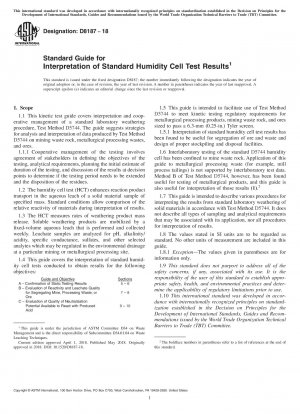ASTM D8187-18
Standard Guide for Interpretation of Standard Humidity Cell Test Results
- Standard No.
- ASTM D8187-18
- Release Date
- 2018
- Published By
- American Society for Testing and Materials (ASTM)
- Latest
- ASTM D8187-18
- Scope
- 1.1 This kinetic test guide covers interpretation and cooperative management of a standard laboratory weathering procedure, Test Method D5744. The guide suggests strategies for analysis and interpretation of data produced by Test Method D5744 on mining waste rock, metallurgical processing wastes, and ores. 1.1.1 Cooperative management of the testing involves agreement of stakeholders in defining the objectives of the testing, analytical requirements, planning the initial estimate of duration of the testing, and discussion of the results at decision points to determine if the testing period needs to be extended and the disposition of the residues. 1.2 The humidity cell test (HCT) enhances reaction product transport in the aqueous leach of a solid material sample of specified mass. Standard conditions allow comparison of the relative reactivity of materials during interpretation of results. 1.3 The HCT measures rates of weathering product mass release. Soluble weathering products are mobilized by a fixed-volume aqueous leach that is performed and collected weekly. Leachate samples are analyzed for pH, alkalinity/ acidity, specific conductance, sulfates, and other selected analytes which may be regulated in the environmental drainage at a particular mining or metallurgical processing site. 1.4 This guide covers the interpretation of standard humidity cell tests conducted to obtain results for the following objectives: Guide and Objective Sections A – Confirmation of Static Testing Results 5 – 6 B – Evaluation of Reactivity and Leachate Quality for Segregating Mine, Processing Waste, or Ore 7 – 8 C – Evaluation of Quality of Neutralization Potential Available to React with Produced Acid 9 – 10 1.5 This guide is intended to facilitate use of Test Method D5744 to meet kinetic testing regulatory requirements for metallurgical processing products, mining waste rock, and ores sized to pass a 6.3-mm (0.25-in.) Tyler screen. 1.5.1 Interpretation of standard humidity cell test results has been found to be useful for segregation of ore and waste and design of proper stockpiling and disposal facilities. 1.6 Interlaboratory testing of the standard D5744 humidity cell has been confined to mine waste rock. Application of this guide to metallurgical processing waste (for example, mill process tailings) is not supported by interlaboratory test data. Method B of Test Method D5744, however, has been found useful for testing of metallurgical products, and this guide is also useful for interpretation of those results (1).2 1.7 This guide is intended to describe various procedures for interpreting the results from standard laboratory weathering of solid materials in accordance with Test Method D5744. It does not describe all types of sampling and analytical requirements that may be associated with its application, nor all procedures for interpretation of results. 1.8 The values stated in SI units are to be regarded as standard. No other units of measurement are included in this guide. 1.8.1 Exception—The values given in parentheses are for information only. 1.9 This standard does not purport to address all of the safety concerns, if any, associated with its use. It is the responsibility of the user of this standard to establish appropriate safety, health, and environmental practices and determine the applicability of regulatory limitations prior to use. 1.10 This international standard was developed in accordance with internationally recognized principles on standardization established in the Decision on Principles for the Development of International Standards, Guides and Recommendations issued by the World Trade Organization Technical Barriers to Trade (TBT) Committee. 1 This guide is under the jurisdiction of ASTM Committee D34 on Waste Management and is the direct responsibility of Subcommittee D34.01.04 on Waste Leaching Techniques. Current edition approved April 1, 2018. Published May 2018. Originally approved in 2018. DOI: 10.1520/D8187-18. 2 The boldface numbers in parentheses refer to a list of references at the end of this standard. Copyright © ASTM International, 100 Barr Harbor Drive, PO Box C700, West Conshohocken, PA 19428-2959. United States This international standard was developed in accordance with internationally recognized principles on standardization established in the Decision on Principles for the Development of International Standards, Guides and Recommendations issued by the World Trade Organization Technical Barriers to Trade (TBT) Committee. 1 2. Referenced Documents
ASTM D8187-18 Referenced Document
- ASTM D5681 Standard Terminology for Waste and Waste Management
- ASTM D5744 Standard Test Method for Accelerated Weathering of Solid Materials Using a Modified Humidity Cell
- ASTM D6234 Standard Test Method for Shake Extraction of Mining Waste by the Synthetic Precipitation Leaching Procedure
- ASTM E1915 Standard Test Method for Analysis of Metal Bearing Ores and Related Materials by Combustion Infrared Absorption Spectrometry
- ASTM E2242 Standard Test Method for Column Percolation Extraction of Mine Rock by the Meteoric Water Mobility Procedure*, 2021-10-01 Update
ASTM D8187-18 history
- 2018 ASTM D8187-18 Standard Guide for Interpretation of Standard Humidity Cell Test Results
